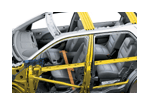TRB Aids Weight Reduction at Ford
 |
By Chris Kassab, FCM
-- If you've ever had trouble shedding a few extra pounds, Ford engineers can empathize.
For years, automotive engineers have worked to trim weight from vehicles in an effort to boost fuel economy and improve driving dynamics. Studies suggest that for every 10 percent reduction in vehicle weight, there will be a six to eight percent decrease in fuel consumption. The challenge has been to develop lightweight construction that does not come at the expense of safety.
"Our job is to find innovative ways to design parts to reduce the weight and total cost of the part while maintaining or surpassing the strength requirements of the body structure," said Bruno Barthelemy, chief engineer, Body Structures. "We now have some technologies that can help us do this."
Structural engineers are currently exploring the use of tailor rolled blank (TRB) technology in the manufacturing process, and it could result in vehicle weight savings of up to 40 percent on the body structure of future Ford vehicles. TRB allows engineers to do something they've not been able to do in the past -- vary the thickness of a part in a single process, giving strength where it is needed and eliminating excess weight where it is not.
"TRB lets us optimize the design in that we put the metal exactly where we need it right in the blank, not by welding-in a reinforcement as a secondary operation," said Karen Mianzo, supervisor, Body Structures.
Traditionally, a piece of sheet metal called a "blank" is stamped into a part. The thickness of the part is constant along the length of the part, regardless of whether or not it ideally needs to be.
Most recently, the concept of combining different pieces of steel into a welded blank was developed to enable product and manufacturing engineers to "tailor" the blank. By laser welding two or more sheets of different grades and thicknesses of steel in strategic places, they could provide optimum strength using the least amount of material possible.
TRB takes the manufacturing process one giant step forward. It enables engineers to continuously vary the thickness along the length of the sheet steel as it is rolled, virtually eliminating the need for welding local reinforcements in the part.
"In this case, not only do you have a 40 percent weight savings, but on top of that, you're creating greater efficiency in the manufacturing process," said Barthelemy.
TRB also provides better structural design due to smooth, rolled transitions (as opposed to "stepped" metal thickness changes), which prevent stress concentrations in the finished part. And due to the nature of the TRB rolling process, there is no cost penalty for multiple thickness transitions.
According to Barthelemy, TRB technology may be used in Ford vehicles as early as 2010.
"The engineering team needs to find the perfect application," he said. "This is new technology, and it is a challenge for us to know where it's going to be the most efficient."


